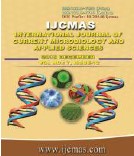


 National Academy of Agricultural Sciences (NAAS)
National Academy of Agricultural Sciences (NAAS)

|
PRINT ISSN : 2319-7692
Online ISSN : 2319-7706 Issues : 12 per year Publisher : Excellent Publishers Email : editorijcmas@gmail.com / submit@ijcmas.com Editor-in-chief: Dr.M.Prakash Index Copernicus ICV 2018: 95.39 NAAS RATING 2020: 5.38 |
The thirty one robusta accessions were analyzed for genetic diversity using RAPD molecular markers. Among the accessions, BR.11 indicated maximum dissimilarity with S.3325 (66 units) followed by S.3311 (61 units) and minimum dissimilarity was in BR.12 and L1 valley robusta (9 units). Three major clusters were observed on the dendrogram with a maximum SED of 63 units among the accessions of first cluster, 58 units in second cluster and lowest of 46 units in third cluster. The first cluster accessions showed morpho-physiologically low root biomass, root to shoot ratio and moderately high total biomass. The second cluster accessions were with reasonably high root biomass and high root to shoot ratio. The third cluster accessions belong to high root and total biomass and water use efficiency types. The Principal Component Analysis (PCA) indicated genetic variation exists between the accessions. The accessions showed with over lapping and little tight clustering in three dimensional PCA revealed relatively low genetic diversity in Indian robusta gene pool. The contrast accessions i.e. S.3334 and L1 valley robusta with respect to root, WUE and associated physiological traits were placed apart in PCAs and differed by 138 SED units and these accessions could be used to raise the mapping population in breeding programme.
 |
 |
 |
 |
 |